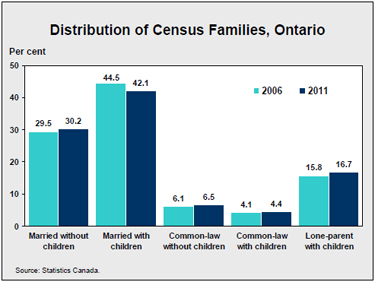Families and Marital Status
Families






- A census family is defined as a married couple or a common-law couple, with or without children, or a lone-parent living with at least one child, living in the same dwelling. A couple can be of the opposite sex or of the same sex.
- The 2011 Census enumerated 3,612,205 census families in Ontario, up 5.5% from 2006. Married-couple families constituted the largest group, but their share declined from 73.9% in 2006 to 72.3% in 2011.
- There were 1,951,440 individuals not belonging to Census families in 2011, most of whom lived alone.
Common-law Couple Families Increasing Fastest
- The Census counted 2,612,895 married-couple families, up 3.3% from 2006. In contrast, the number of common-law-couple families grew nearly four times faster, rising 12.4%, from 351,040 in 2006 to 394,670 in 2011.
- The number of individuals not in a Census family grew rapidly between 2006 and 2011, rising 14.8%.
- The proportion of common-law-couple families rose from 10.3% in 2006 to 10.9% in 2011, while the share of lone-parent families increased from 15.8% to 16.7%.
- The number of lone-parent families increased by 11.8%, from 540,715 in 2006 to 604,645 in 2011. Lone-father families rose faster (18.6%) than did lone-mother families (10.3%).
- Four out of five lone-parent families were headed by women in 2011, a decline from 81.6% to 80.4%.
- In 2011, there were 23,380 same-sex couples in Ontario, which represented 0.8% of all couples. Between 2006 and 2011, the number of same-sex couples increased by 34%.
No Growth in Married Couples with Children
- The number of married couples with children in Ontario was the only family type not to grow between 2006 and 2011. By contrast, the number of married couples without children grew 8.1% over the period.
- As a result the share of married couples without children rose from 29.5% to 30.2%, while the proportion of married couples with children declined from 44.5% to 42.1% over the 2006-11 period.
Marital Status
- The share of Ontario’s population aged 15 and over who are married fell to 50.3% in 2011 from 51.9% in 2006.
- However, the number of married people (legally married and not separated) aged 15 and over grew 3.8% between 2006 and 2011 (from 5.2 million to 5.4 million).
- The 2011 Census enumerated 3.5 million unmarried Ontarians aged 15 and over (never legally married), up from 3.1 million in 2006, an increase of 11.2%. They accounted for 32.8% of the population, up from 31.6% in 2006.
- Those separated, divorced or widowed made up 16.9% of the population in 2011, up from 16.5% in 2006.
Divorced Population Grew the Fastest
- Over the 2006 and 2011 period, the divorced population was the fastest-growing marital status, rising 16.5%.
- The number of divorced Ontarians aged 15 and over increased from 679,990 in 2006 to 792,460 in 2011. They represented 7.4% of the population aged 15 and over in 2011, up from 6.8% in 2006.
- The proportion of Ontario's elderly (65+) who are divorced is relatively low at 7.9% compared to younger age groups (e.g.,13.8% at ages 55-59).
Older Men Married; Older Women Widowed
- Older men are more likely to have a married status and older women are more likely to be widowed.
- In Ontario, 73.6% of men aged 65 and over were married compared to 45.4% of women in 2011. Even at ages 85 and older, a majority of men were married (56.8%), while only 15.0% of women were.
- In contrast, 39.4% of women aged 65 and over were widowed compared to 12.0% of men in 2011.
- The gender difference in marital status results from a combination of factors: (i) women live longer than men; (ii) women tend to marry men older than themselves, which, combined with the gender difference in life expectancy, increases the chance that a women will find herself without a spouse in her older age; and (iii) older widowed men have higher remarriage rates than older widowed women.
October 23, 2012
Contact: Alex Munger (416) 325-0102.